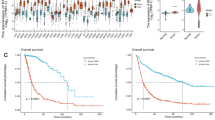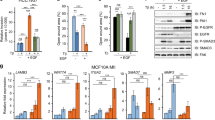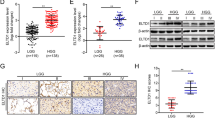Abstract
Tissue factor pathway inhibitor-2 (TFPI-2), a serine protease inhibitor abundant in the extra cellular matrix, is highly expressed in non-invasive cells but undetectable levels in highly invasive human glioma cells. The mechanisms responsible for its transcriptional regulation are not well elucidated. In this study, we made several deletion constructs from a 3.6 kb genomic fragment from Hs683 cells containing the 5′-flanking region of the TFPI-2 gene, transiently transfected with these constructs into non-invasive (Hs683) and highly invasive (SNB19) human glioma cells, and assessed their expression by using a luciferase reporter gene. Three constructs showed high promoter activity (pTF5, −670 to +1; pTF6, −312 to +1; pTF2, −1511 to +1). Another construct, pTF8 (−81 to +1), showed no activity. PTF9, a variant of pTF5 in which a further 231 bp fragment (−312 to −81) was deleted, from the [−670 to +1] pTF5 region, also showed no promoter activity. Hence, (−312 to −81) this region is essential for the transcription of TFPI-2 in glioma cells. Sequencing of this promoter region revealed that it has a high G+C content, contains potential SP1 and AP1 binding motifs, and lacks canonical TATA and CAAT boxes immediately upstream of the major transcriptional initiation site, although CAAT boxes were found about −3000 bp upstream of the transcription start site. We also found a strong repressor in the region between −927 to –1181, upstream of the major transcriptional initiation site, followed by positive elements or enhancers between –1511 to −1181. These positive elements masked the silencer effect. Finally TFPI-2 was induced in Hs683 cells transfected with the pTF6 construct (−312 to +1) and stimulated with phorbol-12-myristate-13-acetate (PMA). We conclude that the −312 to +1 region is critical for the minimal and inducible regulation of TFPI-2 in non-invasive (Hs683) and highly invasive (SNB19) human glioma cell lines.
This is a preview of subscription content, access via your institution
Access options
Subscribe to this journal
Receive 50 print issues and online access
$259.00 per year
only $5.18 per issue
Buy this article
- Purchase on Springer Link
- Instant access to full article PDF
Prices may be subject to local taxes which are calculated during checkout







Similar content being viewed by others
Abbreviations
- TFPI-2:
-
tissue factor pathway inhibitor-2
- PMA:
-
phorbol myristate acetate
- kb:
-
kilobase pair(s)
- bp:
-
base pair(s)
- PCR:
-
polymerase chain reaction
- SP1:
-
stimulatory protein 1
- AP1:
-
activator protein-1
- NE:
-
nuclear extract
- EMSA:
-
electrophoretic mobility shift assay
References
Bajaj MS, Kuppuswamy MN, Saito H, Spitzer SG, Bajaj SP . 1990 Proc. Natl. Acad. Sci. USA 87: 8869–8873
Baker DL, Dave V, Reed T, Periasamy M . 1996 J. Biol. Chem. 271: 5921–5928
Blake MC, Jambou RC, Swick AG, Kahn JW, Azizkhan JC . 1990 Mol. Cell. Biol. 10: 6632–6641
Butzow R, Huhtala ML, Bohn H, Virtanen I, Seppala M . 1988 Biochem. Biophys. Res. Commun. 150: 483–490
Chabannes E, Fauconnet S, Bernardini S, Wallerand H, Adessi G, Bittard H . 2001 Cell. Signal. 13: 585–591
Chaturvedi MM, LaPushin R, Aggarwal BB . 1994 J. Biol. Chem. 269: 14575–14583
Chen L, Mao SJ, Larsen WJ . 1992 J. Biol. Chem. 267: 12380–12386
Enjyoji K, Emi M, Mukai T, Imada M, Leppert ML, Lalouel JM, Kato H . 1993 Genomics 17: 423–428
Girard TJ, Eddy R, Wesselschmidt RL, MacPhail LA, Likert KM, Byers MG, Shows TB, Broze Jr GJ . 1991 J. Biol. Chem. 266: 5036–5041
Gomez DE, Alonso DF, Yoshiji H, Thorgeirsson UP . 1997 Eur. J. Cell. Biol. 74: 111–122
Hascall VC, Heinegard DK, Wight TN . 1991 Cell Biology of Extra Cellular Matrix New York: Plenum Press
Huber R, Schlessinger D, Pilia G . 1998 Gene 214: 35–44
Iino M, Foster DC, Kisiel W . 1998 Arterioscler. Thromb. Vasc. Biol. 18: 40–46
Kamei S, Kazama Y, Kuijer JL, Foster DC, Kisiel W . 2001 Biochimica. Et. Biphysica. Acta. 1517: 430–435
Kazama Y, Kamei S, Kuijper JL, Foster DC, Kisiel W . 2000 Thromb. Haemost. 83: 141–147
Kim M, Lim W, Cha J, An N, Yoo S, Park J, Kim H, Lee Y . 2001 Cancer. Lett. 171: 79–85
Konduri SD, Rao CN, Nirmala C, Anastasia T, Sanjeeva M, Kin Y, Lakka SS, Dinh D, Olivero WC, Gujrati M, Foster DC, Kisiel W, Rao JS . 2001a Oncogene 20: 6938–6945
Konduri SD, Tasiou A, Chandrasekar N, Rao JS . 2001b Int. J. Oncology. 18: 127–131
Konduri SD, Tasiou A, Chandrasekar N, Nicolson GL, Rao JS . 2000 Clin. Exp. Metastast. 18: 303–308
Korner G, Bjornsson TD, Vlodavsky I . 1993 J. Cell. Physiol. 154: 456–465
Lakka SS, Konduri SD, Mohanam S, Nicolson GL, Rao JS . 2000 Clin. Exp. Metastast. 18: 239–244
Lee JK, Tam JW, Tsai MJ, Tsai SY . 1992 J. Biol. Chem. 267: 4638–4645
Lu J, Lee W, Jiang C, Keller EB . 1994 J. Biol. Chem. 269: 5391–5402
McGuire PG, Seeds NW . 1989 J. Cell. Biochem. 40: 215–227
Mimuro J, Schleef RR, Loskutoff DJ . 1987 Blood 70: 721–728
Miyagi Y, Koshikawa N, Yasumitsu H, Miyagi E, Hirahara F, Aoki I, Misugi K, Umeda M, Miyazaki K . 1994 J. Biochem. 116: 939–942
Miyagi Y, Yasumitsu H, Eki T, Miyata S, Koshikawa N, Hirahara F, Aoki I, Misugi K, Miyazaki K . 1996 Genomics 35: 267–268
Nagase H, Woessner Jr JF . 1999 J. Biol. Chem. 274: 21491–21494
Petersen LC, Sprecher CA, Foster DC, Blumberg H, Hamamoto T, Kisiel W . 1996a Biochemistry 35: 266–272
Petersen LC, Bjorn SE, Olsen OH, Nordfang O, Norris F, Norris K . 1996b Eur. J. Biochem. 235: 310–316
Rao CN, Cook B, Liu Y, Chilukuri K, Stack SM, Foster DC, Kisiel W, Woodley DT . 1998 Int. J. Cancer 76: 749–759
Rao CN, Gomez DE, Woodley DT, Thorgeirsson UP . 1995a Arch. Biochem. Biophys. 319: 55–62
Rao CN, Liu YY, Peavey CL, Woodley DT . 1995b Arch. Biochem. Biophys. 317: 311–314
Rao CN, Peavey CL, Liu YY, Lapiere JC, Woodley DT . 1995c J. Invest. Dermatol. 104: 379–383
Rao CN, Lakka SS, Kin Y, Konduri SD, Fuller G, Mohanam S, Rao JS . 2001 Clin. Cancer. Res. 7: 570–576
Schreiber E, Matthias P, Muller MM, Schaffner W . 1989 Nucleic. Acids. Res. 17: 6419–
Sprecher CA, Kisiel W, Mathewes S, Foster DC . 1994 Proc. Natl. Acad. Sci. USA 91: 3353–3357
Udagawa K, Miyagi Y, Hirahara F, Miyagi E, Nagashima Y, Minaguchi H, Misugi K, Yasumitsu H, Miyazaki K . 1998 Placenta 19: 217–223
Vlodavsky I, Folkman J, Sullivan R, Fridman R, Ishai-Michaeli R, Sasse J, Klagsbrun M . 1987 Proc. Natl. Acad. Sci. USA 84: 2292–2296
Vukicevic S, Kleinman HK, Luyten FP, Roberts AB, Roche NS, Reddi AH . 1992 Exp. Cell. Res. 202: 1–8
Werling RW, Zacharski LR, Kisiel W, Bajaj SP, Memoli VA, Rousseau SM . 1993 Thromb. Haemost. 69: 366–369
Acknowledgements
The nucleotide sequence reported in this paper has been submitted to GenBank with accession number AF266279. Supported by National Cancer Institute grants, CA-76350, CA-75557 and CA75692 (to JS Rao) and HL-64119 (to W Kisiel).
Author information
Authors and Affiliations
Corresponding author
Rights and permissions
About this article
Cite this article
Konduri, S., Osman, F., Rao, C. et al. Minimal and inducible regulation of tissue factor pathway inhibitor-2 in human gliomas. Oncogene 21, 921–928 (2002). https://doi.org/10.1038/sj.onc.1204983
Received:
Revised:
Accepted:
Published:
Issue Date:
DOI: https://doi.org/10.1038/sj.onc.1204983
Keywords
This article is cited by
-
Sequential 5-Aza 2′-deoxycytidine/depsipeptide FK228 treatment induces tissue factor pathway inhibitor 2 (TFPI-2) expression in cancer cells
Oncogene (2005)
-
Epigenetic inactivation of TFPI-2 as a common mechanism associated with growth and invasion of pancreatic ductal adenocarcinoma
Oncogene (2005)
-
Promoter methylation and silencing of the tissue factor pathway inhibitor-2 (TFPI-2), in human glioma cells
Oncogene (2003)



